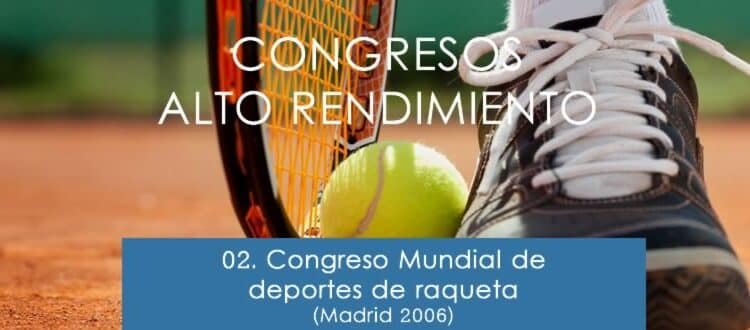Strategies and support mechanisms used by elite australian female tennis players returning to the circuit from injury.
Resumen strategies and support mechanisms used by elite australian female tennis players
Elite athletes in many sports recognise that injury is endemic of their sporting career, and often it is how well an injury is managed that affects the longevity and success a player may experience over that career. With some athletes commencing serious training before reaching puberty, problems may arise from taxing the body at a young age, and a motivated athlete may be keen to demonstrate how (in their perception) ‘dedicated’ they are to the sport by developing overuse injuries (and at a psychological level, experiencing burnout). In studies of athletes’ mood upon returning to sport from an injury, Smith et al. (1990) found that the most seriously injured group experienced significantly more tension, depression, and anger and less vigor than college norms, a mood disturbance that lasted one month. Johnston and Carroll (1998) reported that athletes regained confidence after return to sport from injury, although some took a long time before regaining their previous performance levels. In those cases, a poor performance upon return from injury often resulted in depression, further eroding confidence and sport performance. Chase et al. (2005) examined the mental and physical strategies used by gymnasts to overcome fear of injury. Ten themes emerged from the data analyses including ‘Mental preparation’ (with strategies such as ‘thought stopping’ and imagery to deal with pressure), ‘Coach’s influence’, ‘Positive self communication’, ‘Good Luck objects’ (e.g. lucky earrings and hair ties to help build confidence), ‘Peer support’, ‘Physical preparation’ (e.g. breaking the skill into component parts), ‘Routine of action’(e.g. sticking to the same warm up, prayer and stretching), ‘Thinking of past successful performances’ and ‘Bribe’ (i.e. thinking of a reward to gain if gymnast completed the difficult routine). The researchers argued that although the gymnasts were aged from 12 to 17years, they had already been exposed to several years of psychological skills training and were skilled enough to incorporate these skills to cope with injury. For athletes who are not adapting to the threat of injury or re-injury, Chase et al (2005) recommended coaches and parents look for signs of avoidance that, if not countered, may result in the athlete leaving the sport prematurely.
1. Introduction
Elite athletes in many sports recognise that injury is endemic of their sporting career, and often it is how well an injury is managed that affects the longevity and success a player may experience over that career. With some athletes commencing serious training before reaching puberty, problems may arise from taxing the body at a young age, and a motivated athlete may be keen to demonstrate how (in their perception) ‘dedicated’ they are to the sport by developing overuse injuries (and at a psychological level, experiencing burnout). In studies of athletes’ mood upon returning to sport from an injury, Smith et al. (1990) found that the most seriously injured group experienced significantly more tension, depression, and anger and less vigor than college norms, a mood disturbance that lasted one month. Johnston and Carroll (1998) reported that athletes regained confidence after return to sport from injury, although some took a long time before regaining their previous performance levels. In those cases, a poor performance upon return from injury often resulted in depression, further eroding confidence and sport performance. Chase et al. (2005) examined the mental and physical strategies used by gymnasts to overcome fear of injury. Ten themes emerged from the data analyses including ‘Mental preparation’ (with strategies such as ‘thought stopping’ and imagery to deal with pressure), ‘Coach’s influence’, ‘Positive self communication’, ‘Good Luck objects’ (e.g. lucky earrings and hair ties to help build confidence), ‘Peer support’, ‘Physical preparation’ (e.g. breaking the skill into component parts), ‘Routine of action’(e.g. sticking to the same warm up, prayer and stretching), ‘Thinking of past successful performances’ and ‘Bribe’ (i.e. thinking of a reward to gain if gymnast completed the difficult routine). The researchers argued that although the gymnasts were aged from 12 to 17years, they had already been exposed to several years of psychological skills training and were skilled enough to incorporate these skills to cope with injury. For athletes who are not adapting to the threat of injury or re-injury, Chase et al (2005) recommended coaches and parents look for signs of avoidance that, if not countered, may result in the athlete leaving the sport prematurely. Research by Young et al. (2006) into the retirement experiences of elite female tennis players revealed a high degree of frustration with Australia’s governing body of tennis, Tennis Australia (TA) in terms of the perceived lack of support and recognition for the country’s former players. In their willingness to further explore issues of player welfare, and try to improve psychosocial outcomes for their players, TA commissioned this study to investigate the experiences of professional tennis players who had suffered minor and major injuries. For the purposes of the study, and based on Devonport et al. (2005) suggestion to develop ‘measures grounded in the athlete’, a questionnaire was devised to allow players to relate experiences in their own words. Players’ satisfaction with the speed of identification of the injury, the efficacy of the treatment sought, the effect it had on their mental state, and the perceived support by the national governing body (TA) In helping them return, were probed to determine what, if anything, could be done to better support athletes who become injured. Further, Podlog and Eklund (2005) have suggested that having enforced time off due to an injury may result in the athlete gaining ‘a renewed perspective’ on their life, and consequently, this study sought to examine this issue.
2. Methods
Approval of the study, conforming to the Code of Ethics of the World Medical Association (Declaration of Helsinki), was granted by the Board of Management, Tennis Australia. A letter of invitation, including consent form, and anonymous questionnaire were posted to the players with a self-addressed stamped envelope. The questionnaire was developed by the investigators in response to the specific areas of interest as defined by TA. The 14 page questionnaire consisted of both closed and open ended questions (21 in total) and asked players to recount (a) minor and severe/chronic injuries sustained and how the injury affected their tournament participation; (b) the frequency and type of treatment sought for their injury; (c) attitudinal changes that occurred following minor and severe/chronic injury; and (d) their beliefs about precautions that limited exposure to injury. Descriptive data are reported using frequencies of the sample. Qualitative data were content analyzed, where possible, for key themes and phrases, or reported verbatim in the words of the subjects.
3. Results
Of the 55 participants in the study, at the time of completing the survey, 26 were still active on the circuit, and 28 were retired (average retirement length was 7 years).Of the 26 who were still playing, 24 were not contemplating retiring in the foreseeable future (i.e. within two years), and two players were thinking of retiring within the next 12 months. The average number of years participants had been on the professional women’s tennis circuit was 4.3 years, although five were still on the International Tennis Federation (ITF) circuit and were not yet on the top tier professional tour. The average highest Womens’ Tennis Association (WTA) singles ranking was 501 (three in the top 100, 16 in the top 500), and the highest WTA doubles ranking was 325 (three in the top 100, 25 in the top 500). 3.1 MINOR INJURIES Examining the effect of minor injuries (described as “niggling” or “short-term”) on a players’ career (Table 1), the degree to which a player’s tennis career had been negatively affected (i.e. hampered ability to train and play) by minor injuries was given an average score of 3.8 (signifying ‘hampered, but not extensively’ on a 1-10 point rating scale).
Table 1. Frequency of minor injuries to body parts. (Note: Players could nominate more than one injured body part.)
On a rating scale of 1 to 10 (1 = never withdrawn due to minor injury, 10 = withdrawn from 10 or more tournaments due to the effects of a minor injury), an average score of 2.8 was obtained, indicating that the average player had withdrawn from 1-3 tournaments due to minor injuries. The types of treatments sought to overcome these injuries were extensive. Table 2 shows the frequency of treatment options undertaken by players, assisting their recovery from minor injuries. Many players sought advice from the service providers on-site at tournaments, and some then followed up with appointments with their own doctors for their minor injuries. Following a minor injury, self-treatment was also very popular. Sport psychologists were sought to help overcome problems arising from the injury, with goal setting and self talk being the main skills taught. As well, talking to others, usually those well known to the player, was a strategy used to help with recovery from minor injuries.
Table 2. Frequency of treatments sought for minor injuries (Note: Players could nominate in more than one category).
3.2 SEVERE, OR CHRONIC INJURIES Severe or chronic injuries were those that prevented a player from competing for more than one month. The degree to which a player’s tennis career had been negatively affected (i.e. it hampered ability to train and play) by severe or chronic injuries was given an average score of 3.7 (signifying ‘hampered, but not extensively’ on a 1-10 point rating scale). Table 3 presents a summary of injured body areas.
Table 3. Frequency of severe or chronic injuries to body parts (Note: Players could nominate more than one injured body part.)
On a rating scale of 1 to 10 (1 = never withdrawn due to severe or chronic injury, 10 = withdrawn from 10 or more tournaments due to the effects of a severe or chronic injury), an average score of 2.8 was obtained, indicating that the average player in the sample had withdrawn from 1-3 tournaments due to severe or chronic injuries. The types of treatments sought to overcome these injuries are summarised in Table 4. A more varied range of treatments was sought, with mixed success. Some players admitted to trying to return too soon from their injury, adding to their problems. Some thought their problems occurred initially from over-training. Table 4 shows that severe or chronic injuries were often treated on-site at the tournament and then followed up with appointments to the players’ own doctor. The severe or chronic injury sometimes required surgery, but at some stage of the players’ recovery, they self-treated, as well as received physiotherapy, massage and chiropractic services. In spite of having a severe or chronic injury, fewer players sought the services of a sport psychologist than they did for minor injuries. Talking to others was still an option to help recovery, but ‘talking to other players’ was more likely when a severe or chronic injury had occurred.
Table 4. Frequency of treatments sought for a severe or chronic injury (Note: Players could nominate in more than one category)
With respect to ‘coming back from a severe or chronic injury’ (Table 5), players suggested that a return to previous best form took less than 6 months in 12 cases, and more than 6 months in 8 cases.
Table 5. Time away from the game before returning to competition.
For some, previous good form was never regained after a serious or chronic injury in nine instances. Of those retired (n=25), 15 attributed their decision to do so to reasons other than their inability to recover from their injuries. Players’ perceptions as to changes in their ‘personal values’ as a direct result of being injured were explored, and if they had been largely unaffected by injury, their attribution to this success was also investigated. Only 42% of players said they experienced a change in attitude, however, with the majority claiming their attitude to life was unaffected (at this stage of their life and career). Table 6 summarises the types of responses players made about their ‘change in attitude’ as a result of their injury.
Table 6. Types of attitudinal changes that occurred following severe or chronic injury.
Players were encouraged to make further comments about the treatments, strategies used, and their effectiveness, or whether they wanted to make some recommendations to any future players (Table 7). Players were happy to make recommendations to future players, and many of these recommendations centred on behaviours within the players’ own control (ie stretching in warm up and cool downs, being consistent in their fitness and training, generally ‘looking after themselves’), and most of the recommendations were inexpensive to implement on a regular basis.
Table 7. Players’ beliefs about precautions that limited exposure to severe or chronic injury. (Note: Players could nominate more than one category).
4. Summary and conclusions
The high level of frustration experienced by a perceived lack of support from the National Federation (Young et al, 2006) was not evident among this sample of current or newly-retired players. The players in this sample generally believed that ‘destiny was in their own hands’, unlike the retired players in the Young et al (2006) study, who attributed to their retirement to a ‘lack of support’ and was a raison d’etre for further exploration of these issues in the current study. During their playing career, elite female tennis players in this study had been hampered by minor and severe (or chronic) injuries – almost to the same degree, in terms of tournaments missed – but different body parts were injured. Lower limb injuries were more represented to a greater extent in the injuries classified as ‘minor’ (and many players attributed these to constantly playing on hardcourts), and shoulder, wrist and lower back injuries were the main body parts implicated in those classified as severe or chronic. Overtraining was frequently cited as the cause of a severe or chronic injury, however some injuries occurred when the player tripped and fell (particularly wrist injuries). In Podlog and Eklund’s (2005) study, the positive benefits an athlete acquired after an injury may have arisen from the skewed sample of athletes who had returned from their sport (i.e. overcoming the injury). Their research did not include athletes who had become injured and had not returned to the sport (or chosen to complete the questionnaire). In the present study, only 42% of the players thought there was a positive attitudinal change. Like the present study, Podlog and Eklund (2005) used retrospective recall, which can be open to bias (i.e. if players have successfully returned to sport, the effects of their injury may be looked at ‘through rose-coloured glasses’), however the present study included players who were currently on the tennis circuit (47% of the participants, although a small percentage of those remain injured and unable to play on the circuit at the time of the survey). Although psychological strategies were found to be useful among elite gymnasts in coping with fear (Chase et al., 2005), these skills were not cited frequently by tennis players in assisting them recover from minor or severe or chronic injuries. Players in this study were asked if they had seen a sport psychologist (with reference to some specific psychological skills listed), however, players were not asked if they used these skills to assist in their recovery (i.e. without needing to see a sport psychologist to do so). This issue could be explored in future research. Talking to others was a strategy players used to help overcome injury, but this research is unable to say if it was for a dissociative (i.e. to distract them by chatting about things other than the injury) or an associative purpose (i.e. find out more information from others who may have suffered a similar injury). Players were more likely to talk to family, friends and a coach if suffering a minor injury, but included other players as well only if suffering a severe or chronic injury. In conclusion, the results have been presented to TA with suggestions to: a) Offer professional players (by TA appointed personnel) player-specific support (which includes ongoing medical assistance) to elite female players not currently eligible for support from other tennis-sponsored groups (for example Australian Institute of Sport scholarship holders); b) Provide coach and player education sessions about appropriate levels of training; c) Promote sport psychology skills (such as goal setting, self talk, and imagery) to players of all abilities (via workshops or through the TA website) for use in all aspects of the tennis career (and life generally), but also to utilise them when recovering from injury.
Bibliografía
- Chase, M.A., Magyar, T.M., and Drake, B.M. 2005. “Fear of injury in gymnastics: Self-efficacy and psychological strategies to keep on tumbling.” Journal of Sport Sciences. 23, 465-475.
- Devonport, T.J., Lane, A.M., and Hanin, Y.L. 2005. “Emotional states of athletes prior to performance-induced injury.” Journal of Sports Science and Medicine, 4, 382-394.
- Johnston L.H., and Carroll D. 1998. “The context of emotional responses to athletic injury: a qualitative analysis.” Journal of Sport Rehabilitation. 7, 206-220.
- Podlog, L., and Eklund, R.C. (2005). “Return to sport after serious injury: A retrospective examination of motivation and psychological outcomes.” Journal of Sport Rehabilitation. 14, 20-34.
- Smith, A.M, Scott, S.G., O’Fallon, W.M., and Young, M.L. 1990. “Emotional responses of athletes to injury.” Mayo Clinic Proceedings. 65, 38-50.
- Young J.A., Pearce A.J., Kane R, and Pain, M.D. 2006. “Leaving the professional tennis circuit: Exploratory study of experiences and reactions from elite female athletes.” British Journal of Sports Medicine. 40, 477-83.













